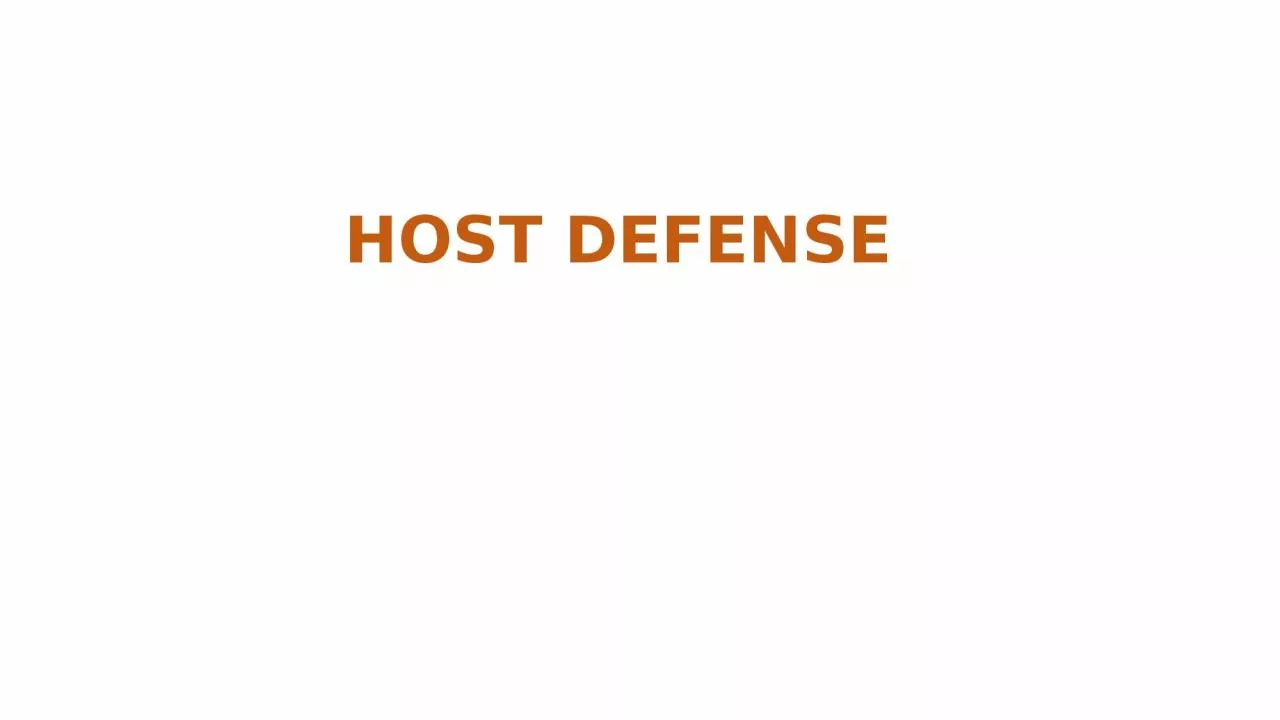

that protect against infection include eg skin mucous membranes Nonspecific immune responses eg phagocytic cells neutrophils macrophages and their products Defenses ID: 934691
Download Presentation The PPT/PDF document "host defense Host defenses" is the property of its rightful owner. Permission is granted to download and print the materials on this web site for personal, non-commercial use only, and to display it on your personal computer provided you do not modify the materials and that you retain all copyright notices contained in the materials. By downloading content from our website, you accept the terms of this agreement.
Slide1
host defense
Slide2Host
defenses that protect against infection include. (eg, skin, mucous membranes) Nonspecific immune responses (eg, phagocytic cells [neutrophils, macrophages] and their products).Defenses against any pathogenSpecific immune responses (eg, antibodies, lymphocytes) Resistance to a specific pathogen
Host Defenses
Slide3Slide4Intact, unbroken skin (Broken skin = port of entry)
Almost all bacteria are incapable to penetrate.skin predominantly inhabited by Staphylococcus epidermidis How? DrynesstemperatureLow pH (acidic) of skin; bacteriocidal secretion by the sebaceous glands Desquamation – sloughing of epitheliumPerspiration (sweat contain lysozymes – attack bacterial cell wall)Exception: Staphylococcus aureus in moist area
First line of defense – physical & chemical barriers
Slide5Eyes
Blinking of eyelidsTears containing lysozymesOuter ear canalWax contains antibacterial componentsMucus membranes – layers of mucosal cells that line body (digestive, genitourinary and respiratory tracts)Mucus is produced by the mucosal cellsContains antimicrobial substance such as lysozymes, lactoferrinMucosal cells are rapidly dividing flush out of body along with attached bacteria
Slide6Digestive
tract Mouth and lower digestive tract – lots ofHow?MucusSaliva (contains lysozyme)Bile (alkaline) in small intestineStomach acidsDefecation (feces contains up to 50% bacteria !)Mucus contain antibacterial agents, antibodies and immune cells called phagocytes
Slide7Genitourinary tract
Urinary tract is sterile in a health person except the distal urethra How?UrinationSecretion (vaginal and seminal fluid)Low pH of vagina (presence of several Lactobacillus sp., Candida albicans
Slide8Respiratory tract
Nose - nasal hair, mucus secretions (phagocytes and antibacterial enzymes).ciliated epithelium (nasal cavity, sinuses, bronchi and trachea)Cough reflexesAlveolar macrophages Microbial antagonism Normal human microbiota. invadersCompete for colonization sitesCompete for nutrientsProduce bacteriocins
Slide9Second line of defense
Once beyond the protective outer barrier of the body, the invading microbes will encounter a series of nonspecific cellular and chemical defense mechanismsMechanisms:Inflammation – a series of events that removes the offending agent and repair the damageChemotaxis – movement of cells toward a chemical influence (chemokines or chemotatic agents)
Phagocytosis
– process in which cell ingest foreign particulate matter e.g. microbes
Many are carried out by the white blood cells in blood
Slide10Erthrocytes
(RBC)
Platelets
Wright’s stain
of the peripheral blood cells can identify granulocytes based on properties of the granules. It contain two dyes:
Eosin dye stains basic cell components
reddish
Methylene blue dye stain acidic cell components
blue-
ish
Second line of defense
Slide11Acute phase proteins
set of plasma proteins whose level increases during infection to enhance host defense mechanisms e.g. complement proteins, coagulating factors, transferrinsCytokinessmall secreted proteins produced by cellsCommunication between different defense systemsExamples: interleukins, interferons
Slide12Fever
Pyrogens are substances that stimulate feverExternal, e.g. bacterial endotoxinInternal (endogenous), e.g. interleukins (IL-1)Body temperature increases in response to pyrogens to:Stimulate WBC to deploy & destroy microbesincrease in immunological response (e.g. proliferation and activation of lymphocytes)Slow down growth of or kill pathogensInterferonsAnti-viral proteins produced by virus-infected cells (eventually died).
Slide13The complement systems
Consists of ~30 proteins that complement the action of the immune systemFunctions: Inflammation Stimulate leukocytesLyse bacteriaIncrease phagocytosis by opsonization
Slide14Four cardinal signs
RednessHeatSwelling PainPrimary functionsLocalize infectionNeutralize toxins at injury siteRepair damage tissueMajor eventsVasodilationIncrease permeability of capillariesMobilization of leukocytes to site of injury (
chemotaxis
& emigration)
Phagocytosis
Inflammation
Slide15Phagocytosis
is the ingestion of microorganisms or other matter by a cell. Many white blood cells engulf invasive microorganisms by the process of phagocytosis. The steps in phagocytosis are:Phagocytosis
Slide16Thanks for your attention